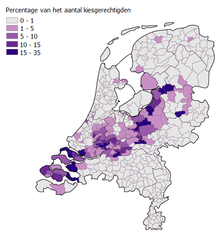Bible Belt (Netherlands)
The Bible Belt (Dutch: bijbelgordel, biblebelt) is a strip of land in the Netherlands with the highest concentration of conservative orthodox Calvinist Protestants in the country. It was named after the Bible Belt of the United States.

The Bible Belt stretches from Zeeland, through the West-Betuwe and Veluwe, to the northern parts of the province Overijssel. Municipalities in this area include Yerseke, Tholen, Ouddorp, Opheusden, Kesteren, Barneveld, Nunspeet, Elspeet and Staphorst. The three biggest cities regarded to be part of the Bible Belt are Ede, Veenendaal and Kampen. Outside the Bible Belt there are other sizable communities of Calvinist Protestants, such as in Rijssen.
Some communities with strong conservative Protestant leanings are situated outside the belt. For example, some municipalities of Friesland such as Dantumadiel have characteristics typical of the Bible Belt. Similarly Urk, considered by many as one of the most traditional communities in the country, is separated from the Bible Belt by the Noordoostpolder which is a polder created in 1942.
The various conservative orthodox calvinist denominations and splinter groups have a combined official membership of about 400 000 people, approximately 2,5% of the entire population, although other sources estimates their share at about 7%.
History
When Flanders and North Brabant were reconquered by the Spanish army during the Eighty Years' War, their Protestant inhabitants were required to either convert to Catholicism or leave. Many emigrated north of the border, particularly during the Twelve Years' Truce of 1609–21. Many of them later became staunch supporters of the pietist movement known as the nadere reformatie (further reformation). Following the 1832 schism, known as the Afscheiding ("Secession"), and the 1886 schism, Doleantie ("Sorrow"), which was led by Abraham Kuyper, they left the mainstream Dutch Reformed Church and founded their own, more conservative congregations, the most notable of which are the Christian Reformed Churches and the Reformed Congregations ("Gereformeerde Gemeenten"), known colloquially as zwarte-kousenkerken ("black stockings churches").
The Bible Belt differs in many aspects (amongst them a regular Sunday church attendance – often twice on a Sunday) from the traditionally Catholic provinces of North Brabant and Limburg to the south (where Sunday church attendance averages between 2% to 3%[1] of the population) and northern parts of the Netherlands, which are traditionally mainline Protestant (dominated by the Protestant Church in the Netherlands[2]) and increasingly secular, with similarly low church attendance figures.
Life and tradition
The church plays a central role in the life of Bible Belt communities and they typically oppose the liberal practices of mainstream Dutch society, such as euthanasia, gay rights, abortion, prostitution, pornography, etc. In Staphorst, for instance, swearing is outlawed and women only wear skirts or dresses.[3] In Bible Belt communities, strong religious tone in public life is accompanied by conservative outlook, preference for large families (the region has relatively high fertility rates), and an emphasis on traditional values. An aspect of Bible Belt society that has drawn the attention of the Dutch general public in recent years (when concerns of a measles epidemic emerged) is the suspicion of parents towards state-run vaccination programmes.[4][5]
The Bible Belt provides a base of support for the small Christian parties SGP and ChristenUnie.[3]
See also
References
- (in Dutch) Jolanda Massaar-Remmerswaal, drs. Joris Kregting “Kerncijfers 2007 uit de kerkelijke statistiek van het Rooms-Katholiek Kerkgenootschap in Nederland,” Rapport nr. 581 (Kaski, November 2008). [Key Figures Roman Catholic Church for 2008.]
- (in Dutch) "Kerncijfers 2007," Radbound Universiteit Nijmegen, KASKI, Onderzoek, Cijfers overige kerkgenootschappen. [Provides an overview of key figures including Sunday (weekend) church attendance for the Protestant Church in The Netherlands for the year 2007.]
- Alexandra Hudson "Seeking security, Dutch turn to Bible Belt," (Reuters: March 12, 2007).
- Tony Sheldon "Netherlands faces measles epidemic" (8 January 2000).
- www.mmrthefacts.nhs.uk Archived September 27, 2005, at the Wayback Machine